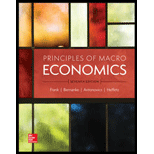
PRINCIPLES OF MACROECONOMICS(LOOSELEAF)
7th Edition
ISBN: 9781260110920
Author: Frank
Publisher: MCG
expand_more
expand_more
format_list_bulleted
Question
Chapter 10, Problem 1P
(a)
To determine
Explain how cigarettes fulfilled the three functions of money in the prisoners’ camp.
(b)
To determine
Explain why the prisoners chose cigarettes to make transactions.
(c)
To determine
Determine whether a non-smoking prisoner would have been willing to accept cigarettes for transactions.
Expert Solution & Answer
Want to see the full answer?
Check out a sample textbook solution
Students have asked these similar questions
(d) Calculate the total change in qı.
Total change:
007
(sp) S
to vlijnsi
(e) B₁ is our original budget constraint and B2 is our new budget constraint after the price of good 1 (p1) increased.
Decompose the change in qı (that occurred from the increase in p₁) into the income and substitution effects. It
is okay to estimate as needed via visual inspection. Add any necessary information to the graph to support your
03
answer.
Substitution Effect:
Income Effect:
everything is in image (8 and 10) there are two images each separate questions
everything is in the picture (13)
the first blank has the options (an equilibrium or a surplus)
the second blank has the options (a surplus or a shortage)
Chapter 10 Solutions
PRINCIPLES OF MACROECONOMICS(LOOSELEAF)
Knowledge Booster
Similar questions
- everything is in photo (19)arrow_forwardIn announcing tariffs on imported steel and aluminum last week, the President said he was imposing a tax on foreign manufacturers who seek to export to the U.S. Is that a fair description of what he did and who will pay? Explain your answer.arrow_forwardAnticipating a severe winter storm, stores stock up on snow shovels and consumers buy snow shovels to be able to clear access to their property. What happens to the price and quantity of snow shovels in the days leading up to the stormarrow_forward
- In the context of supply and demand, describe what equilibrium means? Can a shortage or surplus exist in a market that is left to its own devices? Explain.arrow_forwardTypically, spending in an economy is divided into four components. What are they? Which is the largest component? Which is the most steady from one period to another? Which is most volatile from one period to another? Explain why for your two previous answers.arrow_forwardMichelle Wie, a teenage golf prodigy, earned $16 million from endorsements and $4 million in prize money in 2006. In 2007, she announced that she would enroll in Stanford University for the Fall term. What was her opportunity cost for the 2007-2008 academic year? How does it compare to your opportunity cost of a year at University?arrow_forward
arrow_back_ios
SEE MORE QUESTIONS
arrow_forward_ios
Recommended textbooks for you





 Economics (MindTap Course List)EconomicsISBN:9781337617383Author:Roger A. ArnoldPublisher:Cengage Learning
Economics (MindTap Course List)EconomicsISBN:9781337617383Author:Roger A. ArnoldPublisher:Cengage Learning






Economics (MindTap Course List)
Economics
ISBN:9781337617383
Author:Roger A. Arnold
Publisher:Cengage Learning